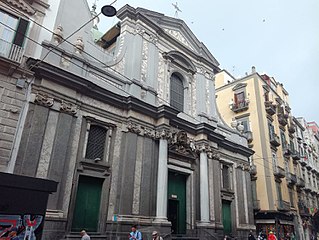
The Grand Canal is a channel in Venice, Italy. It forms one of the major water-traffic corridors in the city.

Ferdinando Fuga was an Italian architect who was born in Florence, and is known for his work in Rome and Naples. Much of his early work was in Rome, notably, the Palazzo della Consulta (1732–7) at the Quirinal, the Palazzo Corsini (1736–54), the façade of the Santa Maria Maggiore (1741–3), and the Church of Sant'Apollinare (1742–8). He later moved to Naples and notably designed the Albergo de'Poveri (1751–81), the façade of the Church of the Gerolamini, and that of the Palazzo Giordano.

Santa Maria Donnregina Nuova is a church in central Naples, Italy. It is called Nuova ("new") to distinguish it from the older Angevin church of Santa Maria Donna Regina Vecchia.

Santa Maria la Nova is a Renaissance style, now-deconsecrated, Roman Catholic church and monastery in central Naples. The church is located at the beginning of a side street directly across from the east side of the main post office, a few blocks south of the Church and Monastery of Santa Chiara. Today the adjacent monastery is a meeting site and hosts the Museo ARCA of modern religious art.

Sant'Anna dei Lombardi,, and also known as Santa Maria di Monte Oliveto, is an ancient church and convent located in piazza Monteoliveto in central Naples, Italy. Across Monteoliveto street from the Fountain in the square is the Renaissance palace of Orsini di Gravina.

San Paolo Maggiore is a basilica church in Naples, southern Italy, and the burial place of Gaetano Thiene, known as Saint Cajetan, founder of the Order of Clerics Regular. It is located on Piazza Gaetano, about 1-2 blocks north of Via dei Tribunali.

The Ospedale degli Incurabili or Complesso degli Incurabili is an ancient and prominent hospital complex located on Via Maria Longo in central Naples, Italy. Part of the complex, including the remarkable pharmacy, are now the Museo delle arti sanitarie of Naples.

The church of St. Nicholas the Charitable is a church located on via Toledo, almost midway between Piazza Carità and Piazza Dante in Naples, Italy.

San Giuseppe dei Ruffi or church of San Giuseppe dei Ruffo is a church located on piazzetta San Giuseppe dei Ruffi, in Naples, Italy.

Santa Maria della Pace is a Roman Catholic church attached to a monastery and hospital, located on Via dei Tribunali corner with Via Castel Capuano, just after the piazzetta Sedil Capuano, in Naples, Italy.

Santa Maria della Stella is a church located on Via Stella 25 in the quartiere of its name in Naples, Italy.

Santa Maria di Monteverginella is a Roman Catholic church in Naples, Italy. To the right of the facade, is the separate Chapel of Santa Maria della Concezione.

Santa Maria delle Grazie Maggiore a Caponapoli or Santa Maria delle Grazie Maggiore is a church located in the historic center of Naples, Italy.

Santa Maria della Sapienza is a Roman Catholic church, located on Via Costantinopoli in central Naples, Italy.

The Palazzo Orsini di Gravina is a Renaissance-style palace on number 3 Via Monteoliveto, in the San Lorenzo quarter of Rione San Giuseppe-Carità, of central Naples, Italy. Since 1940, it has housed the Faculty of Architecture of the University of Naples. It is located across the street and a few doors north of the sleek and modern Palazzo delle Poste. Across the street at the north end of the palace, is the Piazza Monteoliveto with its Fountain and the church of Sant'Anna dei Lombardi.

The Palazzo Venezia is a historical building Via Benedetto Croce 19 in Naples, Italy, a section of a street, Spaccanapoli.

The Palazzo Zevallos Stigliano is a Baroque palace located on Via Toledo number 185 in the quartiere San Ferdinando of central Naples, Italy. It is also called the Palazzo Zevallos or Palazzo Colonna di Stigliano, and since 2014 serves as a museum of artworks, mainly spanning the 17th through the early 20th centuries, sponsored by the Cultural Project of the bank Intesa Sanpaolo. This museum is linked to the Museum or Gallerie di Piazza Scala in Milan and the Museum at Palazzo Leoni Montanari in Vicenza, also owned by the Bank.

Pietro de Marino was an Italian architect born in Naples and active there between 1629 and 1666. His works include the former church of San Potito.

Bartolomeo Picchiatti was an Italian engineer and architect. A short street in the Soccavo area of the city is named after him.

Palazzo di Sangro, also known as either Palazzo de Sangro di Sansevero or Palazzo Sansevero, is a late-Renaissance-style aristocratic palace facing the church of San Domenico Maggiore, separated by the via named after the church, in the city center of Naples, Italy. Part of the palace facade faces the piazza in front of the church, which is also bordered to the south by the Palazzo di Sangro di Casacalenda.






















